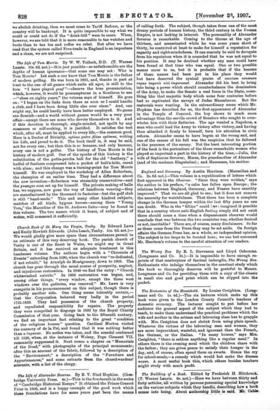The Life of Tom Morris. By W. W. Tulloch, D.D.
(T. Werner Laurie. 10s. 6d. net.)—It is just possible—so unfathomable are the depths of human ignorance—that some one may ask : Who is Tom Morris? Let such a one know that Tom Morris is the father of modern golfing. He was born in 1821, and, thanks in part at least to the one of all games which suits all ages, is still to the fore. "I have played gm/ "—observe the true pronunciation, which, however, it would be presumptuous in a Southron to use —" close on eighty years," the veteran says of himself. He goes on : "I began on the links doon there as soon as I could handle a club, and I have been doing little else ever since." And, one might say, he could hardly have been better employed. No game can flourish—and a world without games would be a very poor affair—except there are some who devote themselves to it. And if this devotion is thorough, single-minded, not spoilt by any meanness or self-seeking, it is justified. It satisfies the test which, after all, must be applied to every life,—the common good. Here is a Doctor of Divinity, optimo patre filius optimus, writing his Life, and proud to do it. The book itself is, it may be said, not for every one; but then this is so because, and only because, every one is not a golfer. The history of Tom Morris is the history of modern golf. Ono of the epochs of this history is the substitution of the gutta-percha ball for the old "feathery," a hatful of feathers compressed into a pocket of bull's-hide, cured with alum ; and this change was a turning-point for Tom Morris himself. He was employed in the workshop of Allan Robertson, the champion of an earlier time. They had a difference about the new invention—Robertson was staunchly conservative—and the younger man set up for himself. The private making of balls has, we suppose, now gone the way of handloom weaving—they are manufactured by the thousand in factories—but the golf club is still "hand-made." This and many other kindred subjects, matches of all kinds, bygone heroes—among them " Young Tom," the Marceline of the St. Andrews links—may be found in this volume. The two names which it bears, of subject and of writer, will commend it sufficiently.


















































 Previous page
Previous page